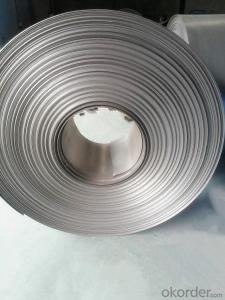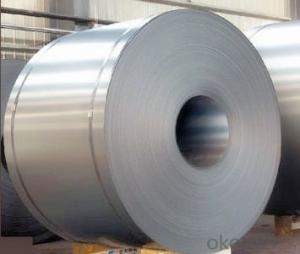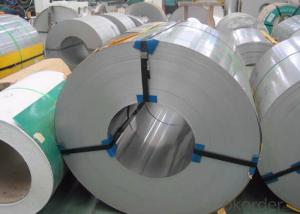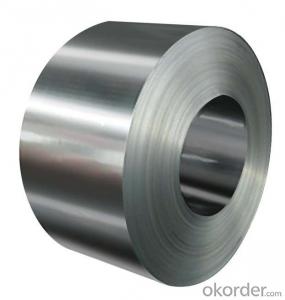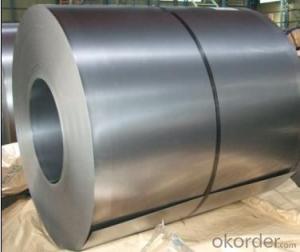201 SERIOUS STAINLESS STEEL COILS/SHEETS
- Loading Port:
- Shanghai
- Payment Terms:
- TT OR LC
- Min Order Qty:
- 50 m.t.
- Supply Capability:
- 20000 m.t./month
OKorder Service Pledge
Quality Product, Order Online Tracking, Timely Delivery
OKorder Financial Service
Credit Rating, Credit Services, Credit Purchasing
You Might Also Like
Specifications
1,2b 201 stainless steel coil thickness0.2~1.5mm
2.Ensure you quality timely delivery
3.2B finish
4.Tolerance 0.01mm
JMSS cold rolled 2b 304 stainless steel coil
Item Details:
1, 2b 304 stainless steel coil with thickness 0.2~1.5mm
2, Finishing: 2B
3, Width: 15~500mm
4. Tolerance: -0.01mm~0.01mm
- Q: Are stainless steel strips resistant to hydrogen sulfide corrosion?
- Yes, stainless steel strips are generally resistant to hydrogen sulfide corrosion. Stainless steel is known for its excellent corrosion resistance properties, and it is particularly resistant to the corrosive effects of hydrogen sulfide gas. The presence of chromium in stainless steel forms a protective oxide layer on the surface, which acts as a barrier against corrosion. Additionally, stainless steel grades with higher amounts of molybdenum, such as 316 and 904L, offer even greater resistance to hydrogen sulfide corrosion. However, it is important to note that the resistance of stainless steel strips to corrosion can vary depending on the specific grade and environmental conditions. Therefore, it is advisable to consult with a materials engineer or corrosion specialist to determine the most suitable stainless steel grade for a particular application involving hydrogen sulfide exposure.
- Q: Can stainless steel strips be used in oil and gas applications?
- Yes, stainless steel strips can be used in oil and gas applications. Stainless steel offers excellent resistance to corrosion and high temperature, making it suitable for various components in the oil and gas industry such as pipelines, tanks, and valves. Its durability and strength make stainless steel strips a reliable choice for these demanding applications.
- Q: What are the benefits of using stainless steel strips?
- There are numerous benefits to using stainless steel strips in various industries and applications. Firstly, stainless steel is known for its exceptional corrosion resistance, making it a perfect choice for environments that are exposed to moisture, chemicals, or extreme temperatures. This resistance to corrosion ensures that the stainless steel strips will have a longer lifespan and require less maintenance compared to other materials. Secondly, stainless steel strips offer high strength and durability. They can withstand heavy loads and resist deformation, making them ideal for applications that require structural integrity and reliability. Whether it's for construction, automotive, or manufacturing purposes, stainless steel strips can provide the necessary strength to meet the demands of a wide range of industries. Thirdly, stainless steel is highly hygienic and easy to clean, making it suitable for applications in the food and medical industries. Stainless steel's non-porous surface prevents the growth of bacteria, ensuring a safe and sanitary environment. Additionally, its smooth surface makes it easy to clean and maintain, saving time and effort in the long run. Moreover, stainless steel strips offer an aesthetically pleasing appearance. The material has a sleek and modern look that can enhance the visual appeal of various products and applications. This makes stainless steel strips a popular choice in architectural and interior design projects. Furthermore, stainless steel is a sustainable and environmentally friendly choice. It is fully recyclable, and using stainless steel strips helps reduce waste and minimize the need for new raw materials. Stainless steel's long lifespan also contributes to its sustainability, as it reduces the frequency of replacements and saves resources in the long term. In conclusion, the benefits of using stainless steel strips include corrosion resistance, high strength, hygienic properties, aesthetic appeal, and sustainability. These qualities make stainless steel strips a versatile and reliable material in various industries, providing long-lasting and cost-effective solutions.
- Q: What are the recommended safety precautions for handling 111 stainless steel strips?
- When handling 111 stainless steel strips, it is important to follow certain safety precautions. These may include wearing protective gloves and safety glasses to prevent cuts and eye injuries. Ensuring proper ventilation in the work area is also crucial to avoid inhalation of any fumes or dust particles released during handling. Additionally, using appropriate lifting equipment or techniques can help prevent strain or injuries to the back and muscles. Regularly inspecting the strips for any sharp edges or defects and storing them in a secure manner can further reduce the risk of accidents.
- Q: What are the common uses of stainless steel strips in the chemical filtration industry?
- Stainless steel strips are commonly used in the chemical filtration industry for various purposes such as structural support in filter systems, as filtration media for removing impurities from liquids or gases, as components in filter elements, and as screens or sieves for separating particles of different sizes. Their corrosion resistance, durability, and high temperature resistance make them ideal for handling corrosive chemicals and maintaining the efficiency of filtration processes in the industry.
- Q: Can 111 stainless steel strips be laser cut for precise shapes?
- Yes, 111 stainless steel strips can be laser cut for precise shapes. Laser cutting is a highly accurate and precise method that can be used to cut through various materials, including stainless steel. The laser beam used in the process is controlled by a computer, allowing for intricate and detailed cuts to be made with high precision. With the right settings and parameters, laser cutting can easily handle 111 stainless steel strips to create precise shapes according to the desired specifications.
- Q: How do stainless steel strips handle exposure to alkalis?
- Due to their strong resistance to alkalis, stainless steel strips are an ideal choice for applications that require exposure to such substances. The presence of chromium in stainless steel creates a protective layer on the surface, called a passive film, which acts as a barrier against corrosion and chemical attacks. This passive film effectively blocks alkalis from penetrating the steel, thereby safeguarding it against potential damage. Moreover, stainless steel's exceptional corrosion resistance and durability enable it to withstand prolonged exposure to alkalis without deterioration or loss of structural integrity. As a result, stainless steel strips are a dependable and enduring material for a wide range of industrial and commercial uses that involve alkalis.
- Q: What is the cost of stainless steel strips compared to other materials?
- The price of stainless steel strips can differ based on factors like the grade of stainless steel, the thickness and width of the strips, and the quantity being bought. Generally, stainless steel strips are pricier compared to materials such as aluminum or carbon steel. This is mainly because of the increased cost of raw materials and the additional processing needed to produce stainless steel. However, the strength, resistance to corrosion, and pleasing appearance of stainless steel make it a popular choice in various industries, including construction, automotive, and manufacturing. Although stainless steel strips may have a higher initial cost, they often offer long-term cost savings due to their durability and low maintenance requirements.
- Q: Can stainless steel strips be used in the aerospace engine components?
- Yes, stainless steel strips can be used in aerospace engine components. Stainless steel offers excellent strength, durability, and resistance to high temperatures, making it suitable for various engine parts such as turbine blades, combustion chambers, and exhaust systems. Additionally, stainless steel's corrosion resistance properties are vital in the aerospace industry, ensuring longevity and reliability in harsh operating conditions.
- Q: Can stainless steel strips be used for cladding purposes?
- Yes, stainless steel strips can be used for cladding purposes. Stainless steel is known for its durability, corrosion resistance, and aesthetic appeal, making it a popular choice for cladding applications. Stainless steel strips can be easily installed on various surfaces, including walls, columns, and facades, to provide a protective and decorative covering. Whether it is for commercial, industrial, or residential projects, stainless steel strips offer a versatile and long-lasting solution for cladding purposes.
Send your message to us
201 SERIOUS STAINLESS STEEL COILS/SHEETS
- Loading Port:
- Shanghai
- Payment Terms:
- TT OR LC
- Min Order Qty:
- 50 m.t.
- Supply Capability:
- 20000 m.t./month
OKorder Service Pledge
Quality Product, Order Online Tracking, Timely Delivery
OKorder Financial Service
Credit Rating, Credit Services, Credit Purchasing
Similar products
Hot products
Hot Searches
Related keywords















